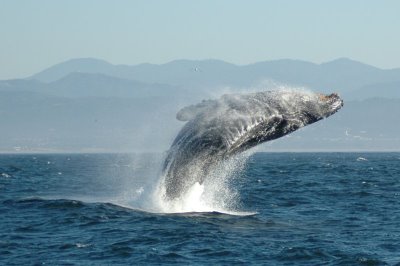Whale Song

A science fiction writer I especially like is Nebula award winner David Brin (of San Diego). One reason why is his "Uplift" series of books in which humanity of the future uplifts animals through genetic engineering to be our equals. Whale song is a factor in the worldview of the uplifteded dolphins in the stories, comprising elements of religion, philosophy, cosmology and poetry. I'm not a fan of genetic engineering but I do like the idea of animals sharing the world with us in a fairer fashion.
I saw this story in the news today ... Humpback whales have "human" brain cells: study ...
WASHINGTON (Reuters) - Humpback whales have a type of brain cell seen only in humans, the great apes, and other cetaceans such as dolphins, U.S. researchers reported on Monday ... Patrick Hof and Estel Van der Gucht of the Department of Neuroscience at Mount Sinai School of Medicine in New York studied the brains of humpback whales and discovered a type of cell called a spindle neuron in the cortex, in areas comparable to where they are seen in humans and great apes ... Although the function of spindle neurons is not well understood, they may be involved in cognition -- learning, remembering and recognizing the world around oneself. ...

And Wikipedia has a lot of info on Humbacks ... here's a litlle of it ...
Alongside its aerial acrobatics, the Humpback Whale is well known for its long and complex "song". As cetaceans have no vocal chords, whales generate their songs by forcing air through their massive nasal cavities. Humpbacks repeat patterns of low notes that vary in amplitude and frequency in consistent patterns over a period of hours or even days. Scientists are still unsure what whalesong is meant to communicate. Only male Humpbacks sing, so it was at first assumed that the songs were solely for courting. While the primary purpose of whalesong may be to attract females, it's almost certain that whalesong serves myriad purposes. Also interesting is the fact that a whale's unique song slowly evolves over a period of years —never returning to the same sequence of notes even after decades ...
It is estimated that during the 20th century at least 200,000 Humpbacks were taken, reducing the global population by over 90%. To prevent species extinction, a general moratorium on the hunting of Humpbacks was introduced in 1966 and is still in force today ... By the time the International Whaling Commission members agreed on a moratorium on Humpback hunting in 1966, the whales had become sufficiently scarce as not to be worthwhile hunting commercially. At this time, 250,000 were recorded killed. However, the true toll is likely to be significantly higher. It is now known that the Soviet Union was deliberately under-recording its kills; the total Soviet Humpback kill was reported at 2,710 whereas the true number is now believed to be 48,000...
Phil Clapham, a scientist at the Smithsonian Institute, says "this wanton destruction of some of the earth's most magnificent creatures is one of the greatest of our many environmental crimes." ... I agree.
Read what Greenpeace has to say about whales and present day whaling.



0 Comments:
Post a Comment
<< Home